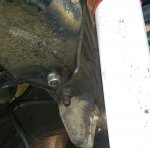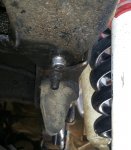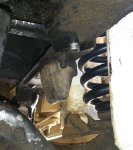blueovalboy69302
New member
- Joined
- May 1, 2017
- Messages
- 2
- Reaction score
- 0
Hello,
I am having an alignment problem with my '81 bronco. When I would turn the wheel left and right the drivers side frame rail at the steering gear would move left and right. I realized there was a weird rivet / bolt holding the engine cross member in place. It does not look factory. This is where the frame is moving in and out (left and right). I am thinking about cutting it off and installing a bolt but I'm not sure I can get a bolt in this location. Just trying to figure out my next course of action! Pictures attached.
Thank you,
Phil



I am having an alignment problem with my '81 bronco. When I would turn the wheel left and right the drivers side frame rail at the steering gear would move left and right. I realized there was a weird rivet / bolt holding the engine cross member in place. It does not look factory. This is where the frame is moving in and out (left and right). I am thinking about cutting it off and installing a bolt but I'm not sure I can get a bolt in this location. Just trying to figure out my next course of action! Pictures attached.
Thank you,
Phil




